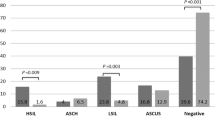Abstract
Purpose
Studying anal cytology to detect intraepithelial neoplasia has been demonstrated to be useful in highly selected populations. This study was designed to determine the frequency of abnormal smears in a wide sample of patients consulting for anorectal symptoms.
Methods
An anal smear was proposed during each consultation during a three-month period.
Results
A total of 205 patients (112 females) were included. After the consultation, visible condylomas were detected in 12 (6 percent) of the cases. Two hundred three (99 percent) smears were able to be analyzed. No case of high-grade squamous intraepithelial lesion was found. Four cases of low-grade squamous intraepithelial lesion were found, all in HIV patients with a history of condylomatous lesions. Forty smears were interpreted as atypical squamous cells of undetermined significance and 159 were normal. The prevalence in this population of low-grade squamous intraepithelial lesion was 19 percent (4/21) in HIV seropositive males, and 15 percent (4/26) in the case of a past history of condyloma. The factors associated with an abnormal smear (low-grade squamous intraepithelial lesion or atypical squamous cells of undetermined significance) were a history of anal condylomatous lesions (odd ratio, 4.9; range, 2.1–11.5), HIV seropositivity (odd ratio, 4; range, 1.6–9.9), and smoking (odd ratio, 2.1; range, 1.1–11.5).
Conclusions
This work confirms that the frequency of low-grade squamous intraepithelial lesion is raised in HIV-seropositive males and also where there is a history of condyloma, which corroborates the necessity for regular monitoring and screening of these patients at risk. This study also suggests that the use of tobacco is associated with anal cytologic abnormalities.

Similar content being viewed by others
References
Johnson LG, Madeleine MM, Newcomer LM, Schwartz SM, Daling JR. Anal cancer incidence and survival: the surveillance, epidemiology, and ends results experience, 1973–2000. Cancer 2004;101:281–8.
Chiao EY, Giordano TP, Palefsky JM, Tyring S, El Serag H. Screening HIV-infected individuals for anal cancer precursor lesions: a systematic review. Clin Infect Dis 2006;43:223–33.
Palefsky JM. Anal human papillomavirus infection and anal cancer in HIV-positive individuals: an emerging problem. AIDS 1994;8:283–95.
Cain JM, Howett MK. Preventing cervical cancer. Science 2000;288:1753–4.
Palefsky JM, Holly EA, Hogeboom CJ, Berry JM, Jay N, Darragh TM. Anal cytology as a screening tool for anal squamous intraepithelial lesions. J Acquir Immune Defic Syndr Hum Retrovirol 1997;14:415–22.
Friedlander MA, Stier E, Lin O. Anorectal cytology as a screening tool for anal squamous lesions: cytologic, anoscopic and histologic correlation. Cancer 2004;102:19–26.
Goldman S, Auer G, Erhardt K, Seligson U. Prognostic significance of clinical stage, histologic grade, and nuclear DNA content in squamous-cell carcinoma of the anus. Dis Colon Rectum 1987;30:444–8.
Etienney I, Balaton A, Daniel F, Sultan S, Bauer P, Atienza P. Anal cytology: feasibility and tolerance. First results from a pilot study. Gut 2005;37(Suppl 1):A143.
Solomon D, Davey D, Kurman R, et al. The 2001 Bethesda System: terminology for reporting results of cervical cytology. JAMA 2002;287:2114–9.
Palefsky JM, Holly E, Ralston MR, Jay N, Berry JM, Darragh TM. High incidence of anal high grade squamous intra-epithelial lesions among HIV-positive and HIV-negative homosexual and bisexual men. AIDS 1998;12:495–503.
Lampinen TM, Miller ML, Chan K, et al. Randomized clinical evaluation of self-screening for anal cancer precursors in men who have sex with men. CytoJournal 2006;20:3–4.
Piketty C, Darragh TM, Da Costa M, et al. High prevalence of anal human papillomavirus infection and anal cancer precursors among HIV-infected persons in the absence of anal intercourse. Ann Intern Med 2003;138:453–9.
Daling JR, Madeleine MM, Johnson LG, et al. Human papillomavirus, smoking, and sexual practices in the etiology of anal cancer. Cancer 2004;101:270–80.
Phillips DH, Hewer A, Schoelefield JH, Skinner P. Smoking-related DNA adducts in anal epithelium. Mutat Res 2004;560:167–72.
Vadjic CM, Anderson JS, Hillman RJ, et al. Blind sampling is superior to anoscope guided sampling for screening for anal intraepithelial neoplasia. Sex Transm Infect 2005;81:415–8.
Lemarchand N, Tanne F, Aubert M, et al. Is routine pathologic evaluation of hemorrhoidectomy specimens necessary? Gastroenterol Clin Biol 2004;28:659–61.
Bauer P, de Parades V, Etienney I, Daniel F, Atienza P. A propos de “Is routine pathologic evaluation of hemorroidectomy specimens necessary ?” fond et sémantique. Gastroenterol Clin Biol 2005;29:213–4.
Arain S, Walts AE, Thomas P, Bose S. The anal Pap smear: cytomorphology of squamous intraepithelial lesions. CytoJournal 2005;2:4.
Goldie SJ, Kuntz KM, Weinstein MC, Freedberg KA, Welton ML, Palefsky JM. The clinical effectiveness and cost-effectiveness of screening for anal squamous intraepithelial lesions in homosexual and bisexual HIV-positive men. JAMA 1999;281:1822–9.
Lytwyn A, Salit IE, Raboud J, et al. Interobserver agreement in the interpretation of anal intraepithelial neoplasia. Cancer 2005;103:1447–56.
Mathews WC, Sitapati A, Caperna JC, Barber RE, Tugend A, Go U. Measurement characteristics of anal cytology, histopathology, and high-resolution anoscopic visual impression in an anal dysplasia screening program. J Acquir Immune Defic Syndr 2004;37:1610–5.
Palefsky JM, Holly EA, Hogeboom CJ, et al. Virologic, immunologic, and clinical parameters in the incidence and progression of anal squamous intraepithelial lesions in HIV-positive and HIV-negative homosexual men. J Acquir Immune Defic Syndr Hum Retrovirol 1998;17:314–9.
Author information
Authors and Affiliations
Corresponding author
Additional information
Supported by a grant from Beaufour Ipsen Pharma. Paris, France
About this article
Cite this article
Etienney, I., Vuong, S., Daniel, F. et al. Prevalence of Anal Cytologic Abnormalities in a French Referral Population: A Prospective Study with Special Emphasis on HIV, HPV, and Smoking. Dis Colon Rectum 51, 67–72 (2008). https://doi.org/10.1007/s10350-007-9098-y
Received:
Revised:
Accepted:
Published:
Issue Date:
DOI: https://doi.org/10.1007/s10350-007-9098-y




